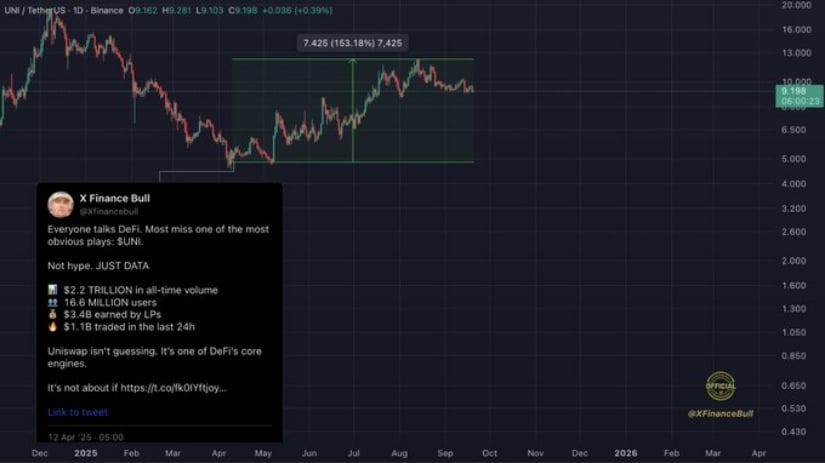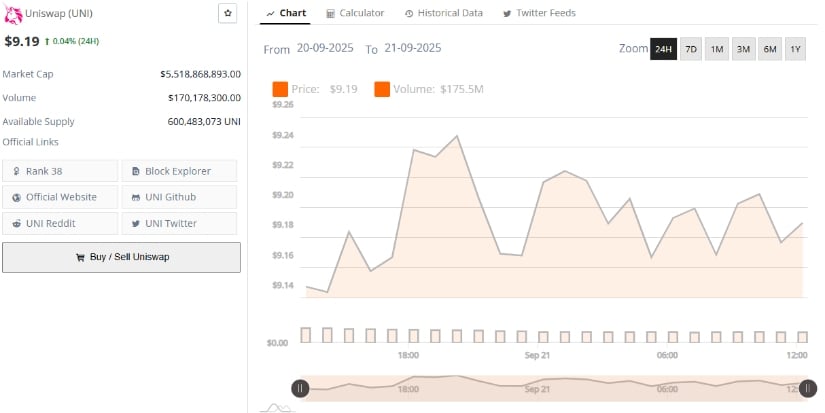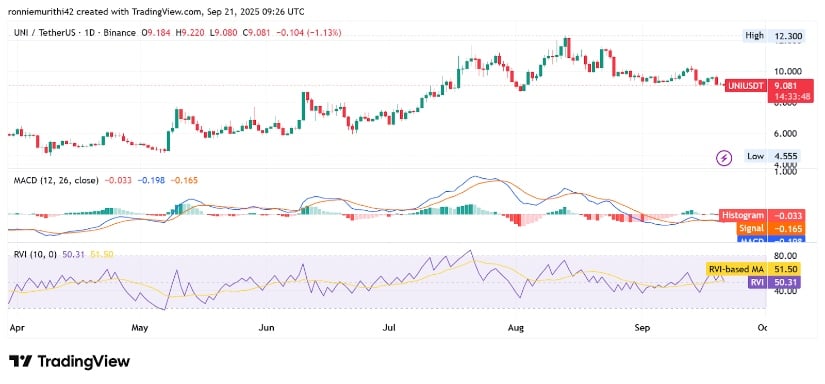UNI Gears Up for Next Bull Run After Surging 100% to $9.19

The rally has caught the attention of traders who are watching for a breakout toward the $12 range, with the asset building momentum on both technical and fundamental strength.
Conviction Pays Off for Early UNI Buyers
In a recent X post, analyst X Finance Bull highlighted how conviction and data-driven analysis led to catching the bottom in Uniswap’s price action. The analyst noted that buying at the lows has already returned over 100%, proving once again that DeFi’s real strength lies in execution rather than theory. The crypto, as a core engine of decentralized finance, has demonstrated resilience through market volatility.

Source: X
The first chart shows the token bouncing sharply off its lows and holding a strong consolidation range between $7 and $13. That 153% rally from the bottom suggests significant demand buildup and renewed investor confidence in the memecoin’s role in powering DeFi infrastructure. X Finance Bull emphasizes this as not hype but a simple observation of liquidity and volume flows.
For traders and long-term holders, this bottom call reinforces the value of disciplined conviction in the market. By identifying accumulation zones and sticking to fundamentals, the coin rebound demonstrates how smart positioning can generate outsized returns when the broader sector regains traction.
Data Supports Long-Term Potential
In supporting the analyst’s views, fresh data from BraveNewCoin provides strong fundamentals. Uniswap currently trades at $9.19 with a market cap of $5.51 billion, ranking #38 among crypto assets. Daily trading volume sits at $170M+, reflecting ongoing market participation and liquidity despite price consolidation.

Source: BraveNewCoin
The supply dynamics are also clear — 600 million tokens are in circulation, ensuring transparent tokenomics. Unlike speculative projects, the token backs these figures with proven on-chain activity, processing billions in volume across DeFi markets. These hard numbers reinforce the notion that the asset is not just a narrative play but an operational backbone in decentralized finance.
Technicals Signal a Cooling Period
At the time of writing, the coin was trading at $9.19 according to TradingView data. Recent price action shows UNI pulling back from highs near $12.30, with support forming around the $9 level. MACD readings (-0.030) indicate a slight bearish crossover, while the histogram remains close to neutral, suggesting reduced momentum.

Source: TradingView
The Relative Vigor Index (RVI) also hovers around 50.4, signaling indecision as bulls and bears battle for short-term control. Price remains above the key low of $4.55, maintaining a strong higher-low structure that keeps the broader uptrend intact. Consolidation around current levels may serve as a healthy reset before another push higher.
If the asset holds above $9, it could provide a launchpad for a retest of resistance in the $11–$12 range. Conversely, a breakdown below this level may invite further correction toward $7.50, where strong buying previously emerged. Overall, the technicals suggest the crypto is in a cooling period, building the base for its next significant move.
También te puede interesar

20+ Best Telegram Casinos & Gambling Sites: Our Top Picks & Reviews

The Role of Blockchain in Building Safer Web3 Gaming Ecosystems
- Immutable Ownership of Assets Blockchain records can be manipulated by anyone. If a player owns a sword, skin, or plot of land as an NFT, it is verifiably in their ownership, and it cannot be altered or deleted by the developer or even hacked. This has created a proven track record of ownership, providing control back to the players, unlike any centralised gaming platform where assets can be revoked.
- Decentralized Infrastructure Blockchain networks also have a distributed architecture where game data is stored in a worldwide network of nodes, making them much less susceptible to centralised points of failure and attacks. This decentralised approach makes it exponentially more difficult to hijack systems or even shut off the game’s economy.
- Secure Transactions with Cryptography Whether a player buys an NFT or trades their in-game tokens for other items or tokens, the transactions are enforced by cryptographic algorithms, ensuring secure, verifiable, and irreversible transactions and eliminating the risks of double-spending or fraudulent trades.
- Smart Contract Automation Smart contracts automate the enforcement of game rules and players’ economic exchanges for the developer, eliminating the need for intermediaries or middlemen, and trust for the developer. For example, if a player completes a quest that promises a reward, the smart contract will execute and distribute what was promised.
- Anti-Cheating and Fair Gameplay The naturally transparent nature of blockchain makes it extremely simple for anyone to examine a specific instance of gameplay and verify the economic outcomes from that play. Furthermore, multi-player games that enforce smart contracts on things like loot sharing or win sharing can automate and measure trustlessness and avoid cheating, manipulations, and fraud by developers.
- Cross-Platform Security Many Web3 games feature asset interoperability across platforms. This interoperability is made viable by blockchain, which guarantees ownership is maintained whenever assets transition from one game or marketplace to another, thereby offering protection to players who rely on transfers for security against fraud. Key Security Dangers in Web3 Gaming Although blockchain provides sound first principles of security, the Web3 gaming ecosystem is susceptible to threats. Some of the most serious threats include:
